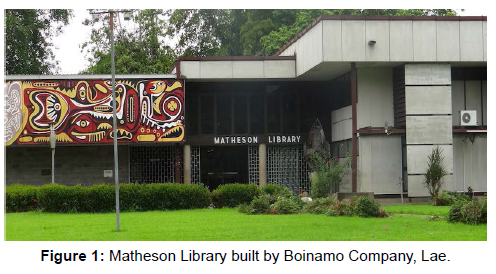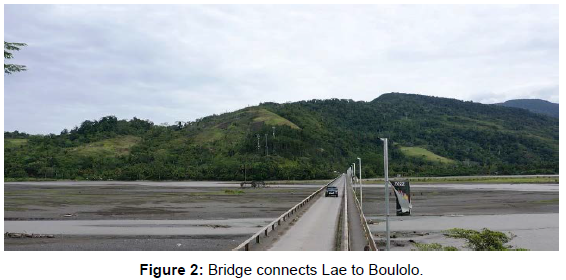Training In Water: Discover Possibilities In Png
Received: 01-Aug-2022 / Manuscript No. IEP-22-73159 / Editor assigned: 03-Aug-2022 / PreQC No. IEP-22-73159 (PQ) / Reviewed: 17-Aug-2022 / QC No. IEP- 22-73159 / Revised: 22-Aug-2022 / Manuscript No. IEP-22-73159 (R) / Published Date: 29-Aug-2022 DOI: 10.4172/2576-1463.1000301
Abstract
This study describes the Hydraulic Wing of the Civil Engeneering Department of Unitech and the possibilities of Employment in Water Environment in a developing country: Papua New Guinea.
Introduction
The Department of Civil Engeneering at UNITECH was extablished in 1968 in Lae (second largest PNG city) contextually with the Institute of Higher Education later called Institute of Techonology of Unitech. Civil Engeneering, together with the Department of Survey and Land Studies was one of the two pioneer Departments founded before the country Indipendence which happened in September 16th 1975.
In 1971 the Department graduated its first three Civil Engineers, still Australian citizens at that time; while nowadays, according to recorded data, more than 1000 students graduate with a Bachelor of Engeneering in total Unitech.
According to Australia University Statute, which PNG still adopts, Engeneering path covers a total period of four years organized in: first and second semester of 15 weeks each year [1]. At the end of a singular semester the exams sessions take place and within a singular semester a week break addressed only to studies is comprised.
The number of students have grown steadily over the years reaching more than 50 persons in 2017. Still the country has very remote and pristine territories (expecially the Highlands) which are hardly reachable and can afford very little facilities (i.e. Water direct distribution and supply, electric power, communication lines...)
The number of students have grown steadily over the years reaching more than 50 persons in 2017. Still the country has very remote and pristine territories (expecially the Highlands) which are hardly reachable and can afford very little facilities (i.e. Water direct distribution and supply, electric power, communication lines...) The Department remains the only Civil Engeneering school both for the country and nearby indipendent territories (Figure 1). Scholars from Salomon and Vanatu Islands reach Lae to unfold their studies. The University protracts the unaivable necessary duty of preparing graduates to take the relevant responsabilities in a national striving growth.
Recently the Department has seen the enrolment of several higher degrees candidates having graduated 2 Phd and three Master scholars.
Water Disciplines
Focusing on Water Environment mostly, PNG offers a spread variaty of opportunities. The land is overall rich of water and big unregulated rivers, whith a inner high production. The highest challenge is still to be able to invest in such a pristine land and preserve its unique flora and stunning beauty. Water disciplines at UNITECH span from: Fondumental of Hydraulics, Hydrology, Water for Agricolture, Fluid Mechanics and are generally provided during the third and fourth year of studies. At the Department of Electrical Engeneering some courses of Hydropower Production are also available. Lessons are generally unfolded through the traditional method (relying mostly on notes) and through the Google Classroom approach. The new entry of internet method allows the students to be more responsive in their learning process and to avoid the peculiar shyness of partecipation in class. Hydrological information is mostly available at the Matheson Library which is the University Library located inside the Campus.
Additional hydrotermical information can be gained at the Water Bureau located in Boroko, Port Moresby. Still, information is very poor due to the lack of installed measuraments and to the difficulties in communication and signal trasmission. In most of the country internet access is unavailable and even in the Campus of Lae (which represents the Paramount of Technical knowledge) power and internet outages are very recurring. It is out of doubt that the Internet Line which travels from the Eastern Provinces to Lae covers a path in thick forests where local dwellers often operate line removals and cut offs to comply to their necessities.
Henceforth the Campus can be isolated for long periods and such episods are not uncommon. A reinforcement of the Internet network is a challenge and is still highly recommended.
Information about the major rivers: Sepik, Ramu, Fly, Markham and Purari is still attributable to Land Surveys and Campaign of the Sydney Water Service. In the nutshell we can say that most of the information has been fetched by the Australian Goverment and can be attributed back to late 1960s. This lack of updated information can stimulate a wide opportunity in Instrumental installations in terms of Hydrometrical gauges such as: rainfall and temperature instruments mostly.
Next to the Campus of Unitech Lae, is the delta of the Markham river and the Hijio Markham Bridge which is the longest bridge in PNG. The bridge is more than 60 years old and needs reinforcement as it is subjected to the floods which occur during intensive rainfalls in July [2]. Markham river , besides major other rivers, has hydrometrical information collected mostly at yearly scale. Its maximum yearly streamflow equals 4 m3/s while average flow reaches 1.2 m3/s.
The river merges in the Hudson Gulf where recently several Australian oil complanies have addressed their interests.
Unitech provides a Hydraulic Laboratory with three open channels where experiments of flow regimes (Hydrulic Jumps) can be conducted. Apart from the laboratory, streamflow measures campaign are also carried out mostly on the Bumbu River, a small river inside the city of Lae. Since there is very few collected information, hydrological considerations and modelling cannot be developed at UNITECH yet and both consist in a opportunity for future.
Moreover, knowing how much can be yielded from a catchment is a challenge much perceivable when the situation for raw data collection is improved. Hydropower production, besides hydrometrical information, represents another big possibiliy for the country in general. National Power is controlled by PNG Power. The biggest Hydropower station is now located in northern part of PNG, deriving water from the Ramu river. The plant, also named Ramu1 and produces a peak power of 50 MW (Figure 2). Another big plant is located in Enga Province in Eastern Highlands. Still the desired scenario consists in the possibility to develop small and widespread plants, even mini hydro, which would be able to cover the entire territory and would supply power whose production is now limited into very few plants and stopped at stage of 13%.
Another big challenge is water network distribution. The city of Lae and its facilities (UNITECH, primary and secondary schools, Angau Hospital) can rely on a 50 years old network which is quite flexible in respect to the tropical weather typical of Papua New Guinea. Unfortunately, small villages and remote areas cannot rely on the equal favourable conditions and dwellers generally need to cover long distances to provide water for nourishing and sanitary purposes.
Irrigation system for agricolture is provided automatically mostly in cities (i.e. Port Moresby, Mendi and Lae). These shortcomings nowadays, whilst water availability is still out of discussion, seem to constraint the development of a country full of inner and unquestionable possibilities.
References
- Attenborough D (2021) Journeys to the other side of the world, Quercus ED.
- Bond M, Briscoe PT, Keryn C, Naomi F, Natt T, et al. (2015) The sustainability of rural water, sanitation and hygiene in Papua New Guinea. Water Australia 42: 42-45.
- Battharal T, Vaidya S (2020) Hydro to play a major role in PNG’s power development plans, Int J Hydropower Dams 27: 1.
- D’Albertis LM (1881) New Guinea: What I did and what I saw.
- Filer C, Kolim K (2003) The Water Resources Management Regime in Papua New Guinea. ANU Publications 63:79-83.
- Moresby J (1900) New Guinea and Polynesia, Elibron Classic.
Indexed at, Google Scholar, Crossref
Citation: Carcano E, Konzang M (2022) Training In Water: Discover Possibilities In Png. Innov Ener Res, 11: 301. DOI: 10.4172/2576-1463.1000301
Copyright: © 2022 Carcano E, et al. This is an open-access article distributed under the terms of the Creative Commons Attribution License, which permits unrestricted use, distribution, and reproduction in any medium, provided the original author and source are credited.
Share This Article
Recommended Journals
Open Access Journals
Article Tools
Article Usage
- Total views: 1707
- [From(publication date): 0-2022 - Dec 18, 2024]
- Breakdown by view type
- HTML page views: 1488
- PDF downloads: 219


